|
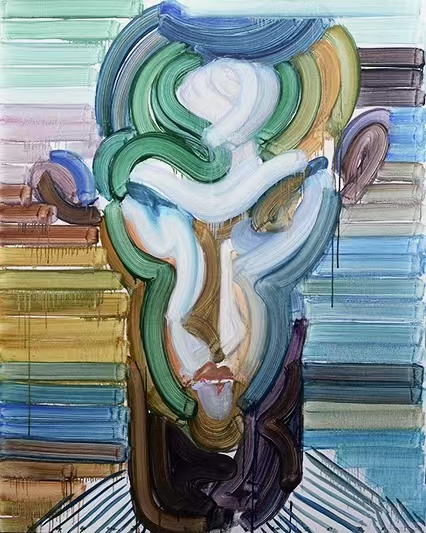
江上越个展“一期一会”海报作品 ⒸEtsu Egami
白石画廊香港空间,举办了日本艺术家江上越*(Etsu Egami)的香港首次个展“一期一会”。在长达一年的疫情的经过,让人们思考生命的短暂,擦肩而过相遇的人脸。此次展览邀请了美国作家,纽约市视觉艺术学院的教授芭芭拉·波洛克(Barbara Pollack)作为学术主持。以下是她对江上越的展览文章。
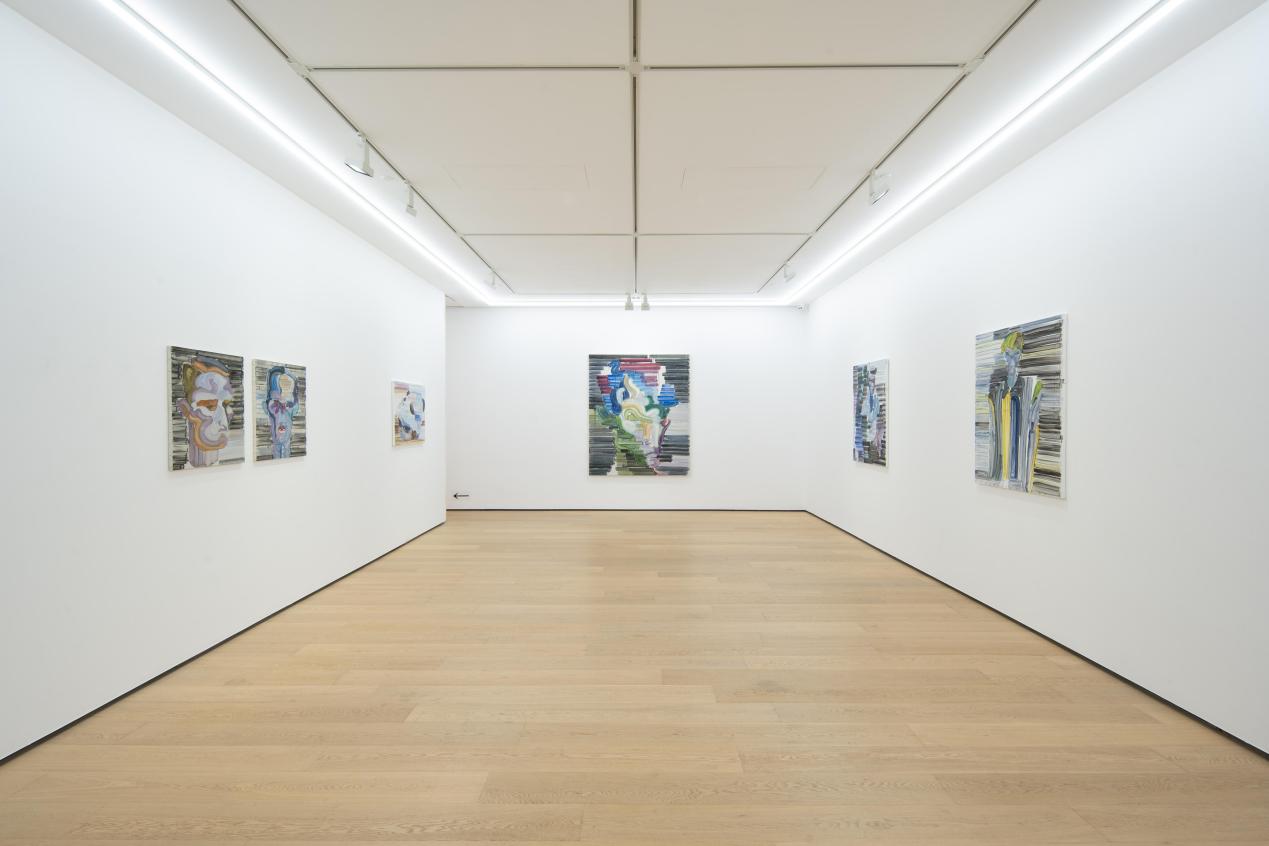
江上越个展“一期一会”现场 白石画廊香港 ⒸEtsu Egami
“我喜欢樱花仅仅在短时期内绽放。我珍惜那些曾经经过我身旁人群的脸庞。尽管有许多的误解和错位,但毕竟是一个去了解彼此生活和交换信息的机会和开端”,江上越曾说过。
一期一会,是此次江上越绘画作品展览的主题,从精神格言的角度来接受生命短暂的更通俗说法,可以简单的翻译(从日文到英文)为“生命中仅仅一次的相遇”。在日文中这个成语如同禅宗的深奥,将转瞬即逝的欣赏提升为生活的理想方式。在英语中“生命中仅仅一次的相遇”是一个摇滚乐队歌曲的主题,正如来自脸部特写(Talking Heads)乐队歌手大卫·拜恩重复所问的,“这不是我美丽的家吗?这不是我美丽的妻子吗?我如何才可以到达这里?”每种语言的声调的不同是一个完美的例子去诠释这些误译、误解和交流不畅,这些事件艺术家曾经在学校或者在生活中经历过。
江上越是一位领先的极具代表性的第三代当代艺术家。1994年出生于东京郊区,在美国和欧洲度过了她的童年,这很好的部分诠释了她自然地倾向去探索这些“误译”。她目前在位于北京的中央美术学院攻读博士学位,在那里也完成了她的本科学位(2016年)和硕士学位(2019年),期间她在卡鲁斯鲁厄艺术与设计大学学习了一年。她所提取的合作教授点亮了她作品的展示形式。现在她和刘晓东工作,一位杰出的中国当代艺术家;在德国和Omar Fast工作,一位概念型电影制作人,他在作品中去挑战线性叙事的概念和艺术家通过实力来表达事实的信念。与此同时这些导师也使江上越受益匪浅,她现在掌握了一种短暂真实性的描绘画像的方式,并发展了这种绘画方式,这种绘画方式是艺术史上对传统脸部描述的重新构造和编排。
脸部是江上越首选的创作题材,她花费多年凝视当她在美国、欧洲和中国旅行时遇到的他人的眼睛,来尝试找出他们和她在说什么。在这些地方她的日语母语不会被讲或不容易被理解,她感觉到交流上的无能为助。在那里的时刻是完全交流上的缺失,或者仅仅通过声音语调和面部表情才能理解,这些深深的根植到艺术家的精神中。所以我们遇到这些面对面的人,并不是历史形象上的遗产或者来自当代艺术名人花名册,而是那些江上越准备展览中途遇的普通民众。
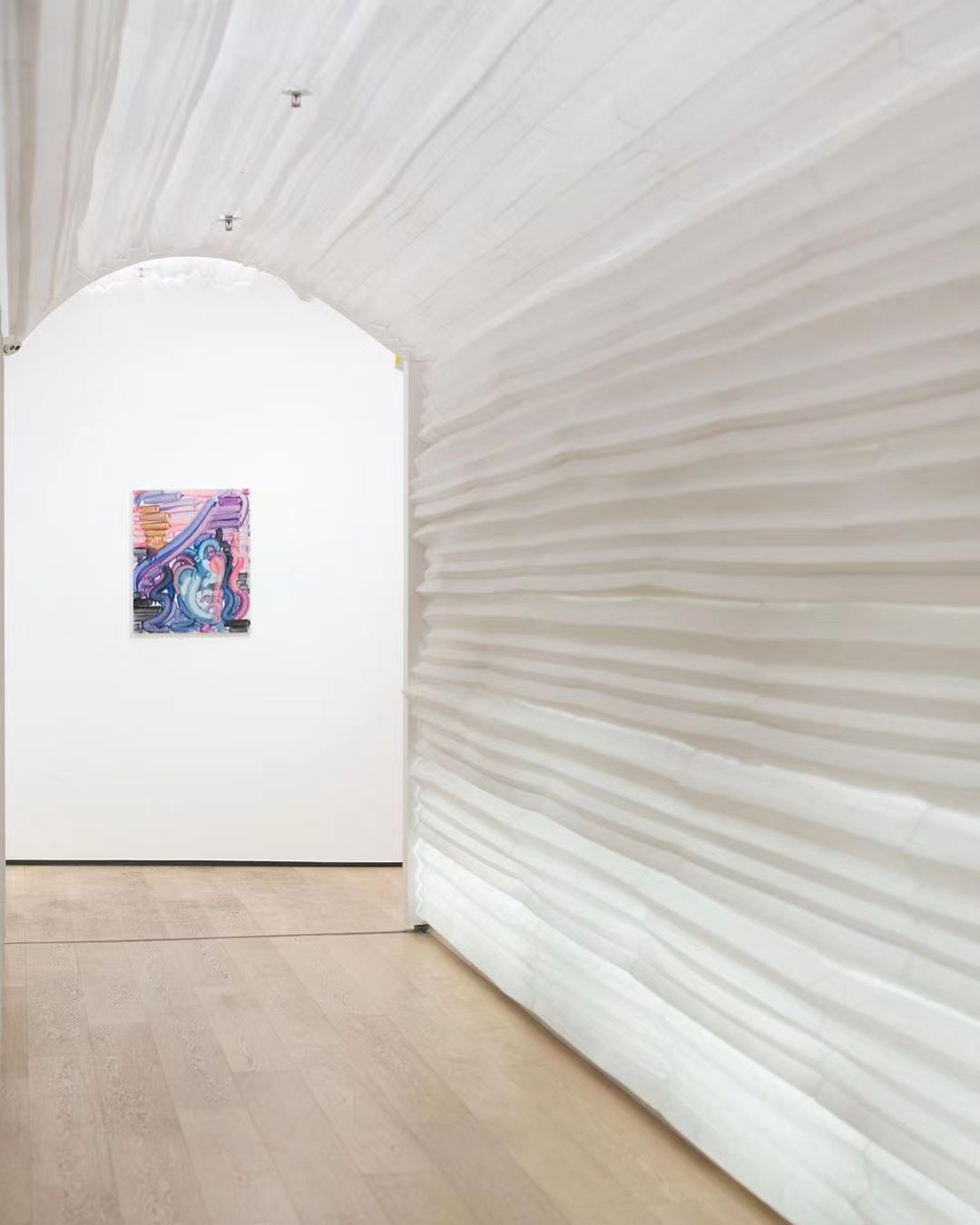
江上越个展“一期一会”现场 白石画廊香港-1 ⒸEtsu Egami
面部描述实际上在近期是极具争议性的甚至危险的,存在着对面部识别科技的极大敌意,比如某人畏惧控制活动手段和侵犯当事人的隐私。与此同时人们却在社交媒体上无节制发出各种自拍照片,放弃尊重隐私权。这种脸部展示的普遍性赋予江上越灵感并值得进一步去研究。正如反对美国艺术家查理·布莱斯仅仅从Instagram挪用照片,江上越再次创造出如何去表达一张脸,如何去观察一张脸和如何画出一张脸。大多数的我们,当我们去观测婴儿的照片或者驾驶证时所了解,面部是千变万化和短暂的,它会随着年龄增长而变老,它会呈现我们的情绪,它甚至也可能揭示人的某种真实。但是它,不像艺术,而是短暂的。但如何在不破坏肖像的情况下捕捉这种质量呢?
江上越把这些肖像合并到她毕业后的装设中,《误听游戏》(2016年)。尝试合并交流的“声音”作为作品脸部的呈现,她开启互交模式,投入到社交上的表达。当他们尝试去重复上一个游戏者对他们说的话时,参与者之间的理解会恶化。待完结后江上越创作了每个参与者的作品系列。这些作品是采用粗狂的笔触和纯粹的层次去渲染脸部的开端,完全不同于传统大师的作品或现有的当代艺术作品。
在这些放任的人性诠释里,江上越聪明的创作了一个小失误,可被称作视觉上的白色噪音。用电脑创作的画作通常会存在这些小失误,例如像素恶化或从故障打印机出现的错误涂抹墨渍。一些艺术家已经在尝试表达这种新的美学,因为这些新媒体提供的断层线条的完美性比那些用软件和apps制作的画面更加有趣味。
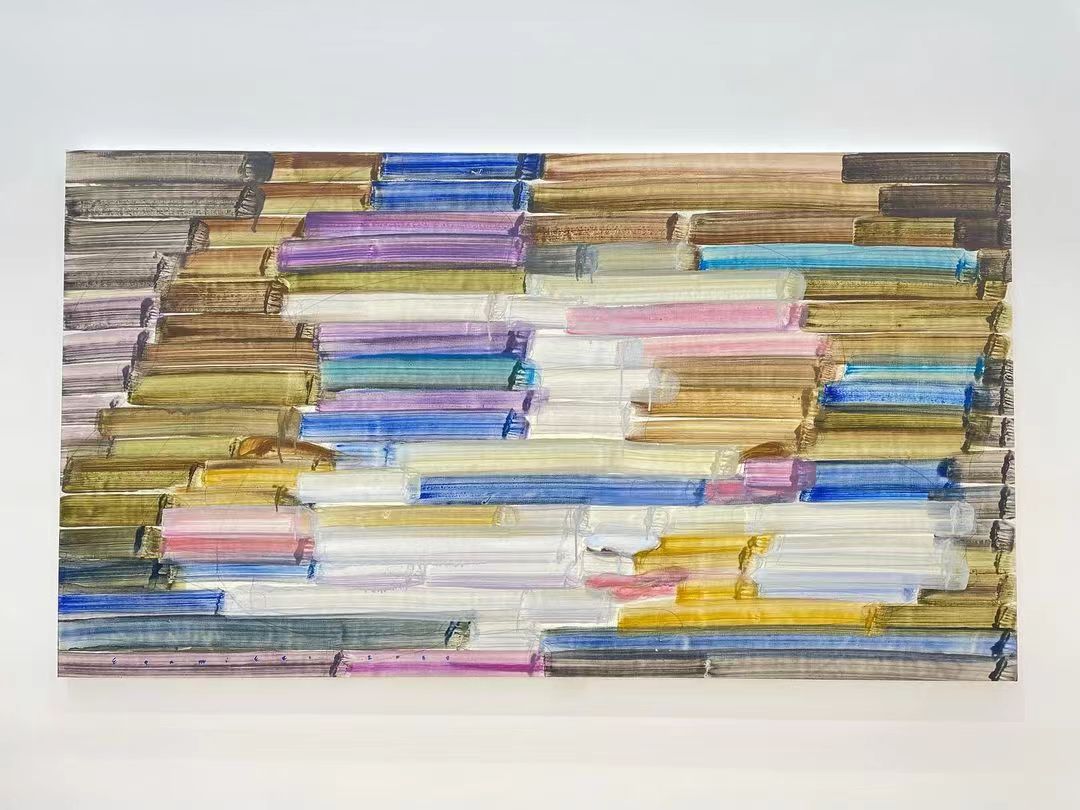
江上越个展“一期一会”现场 白石画廊香港-3 ⒸEtsu Egami
在2020年创作的作品系列《彩虹》中,纯粹色彩的粗狂的笔触在平行线的背景中呈现脸部的特征,如同出了故障的投影仪。或者在她的作品系列《社交距离》中,身体从柔和的云雾中呈现而成为焦点。在作品系列《其他》中可以看到著名的文学家但并不清晰,仿佛他们的影响力已随时间而逝。这些多样形式的小失误是为了传达短暂的时间和瞬间即逝的美。诚然,没有一种方式是确定的或限定的。在作品系列《彩虹》中,转瞬即逝的第一次相遇从来不会被重演或保留。在作品系列《社交距离》中,依据一句老话“不相见,倍相思”,展示着人们之间的交流不畅,以及从距离中产生的渴望。在作品系列《其他》中,名气和重要意义经不起时间的流逝,无论作品成就是多么辉煌和荣耀。实际上,这也是引人入胜之处,江上越选择了这些有着广泛社会评论以叙事而闻名的作家。艺术家本人也在尝试着去达成一些类似于佐拉或托尔斯泰的成就。
所有这些作品都是在北京第一波的疫情中创作,期间旅行是不可能的,特别是它们是属于封城这段期间,其实也是我们不得不“活在当下”的时期。疫情框架出这些作品,改变我们对“一期一会”这个成语最初始的理解。死亡的光环盘旋在这些作品的表面,从不要求我们去检视它的影响而这个影响是确实如此。相当一部分作品是去年创作的。江上越的作品展示了一些最有意义的。也许是因为深深根植于她的DNA,看起来江上越在探索社交距离——语言或文化差异的距离——并贯穿于她的艺术生涯。她并不是随波逐流或者更糟糕,来利用这场世界范围的灾难。在她的脸部画作中,我们观测到了人性。这些画作让我们想去邂逅这些人物并开始一段交谈,也许是为了持续更多的困惑,或者也许是为了寻找出我们有能力去跨越彼此之间的异同并彼此理解。
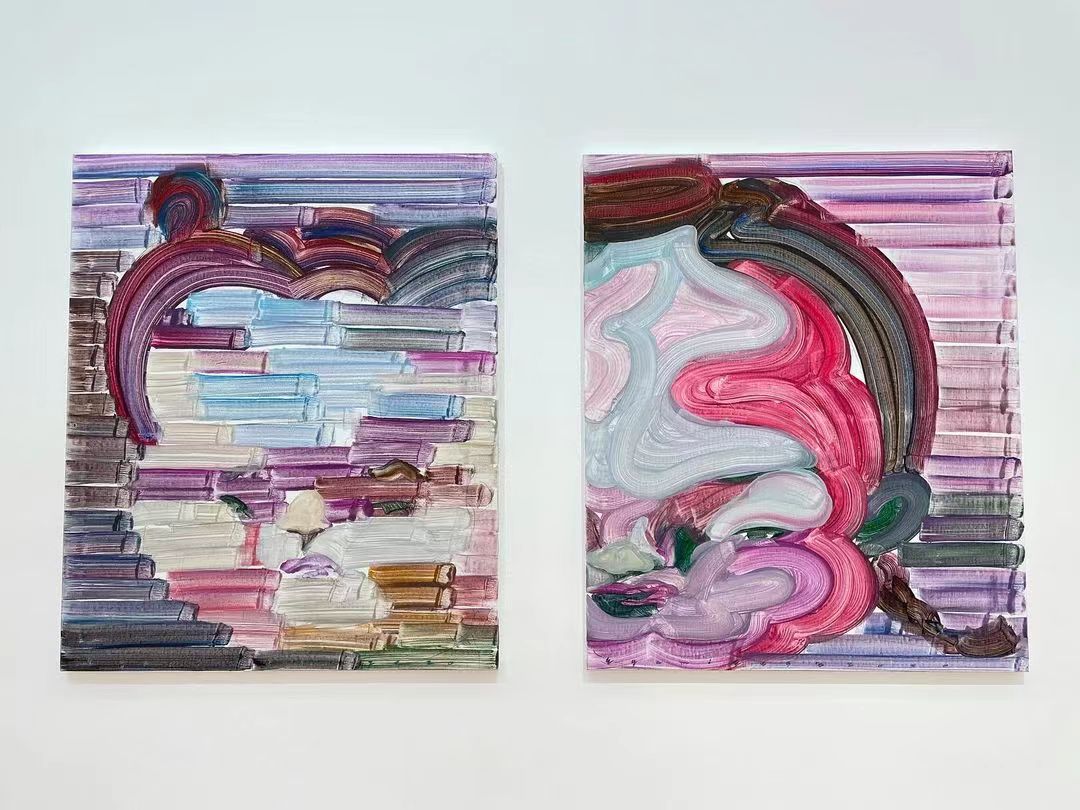
江上越个展“一期一会”现场 白石画廊香港-4 ⒸEtsu Egami
Ichi-go ichi-e or Once in a Lifetime
Whitestone Gallery, Hong Kong
Whitestone gallery Hong Kong announced that curate Etsu Egami first solo show in Hong Kong. The curator is Barbara Pollack, professor at the School of Visual Arts in New York City and she loves Etsu Egami art work, that wrote the texts for solo show.
“I like cherry blossoms that bloom for a short period of time. I cherish the faces of people passing by. Although there are more misunderstandings and dislocations, they are (after all) an opportunity and a beginning to understand life and exchange information,” Etsu Egami.
Ichi-go ichi-e, the title of this wonderful collection of paintings by Etsu Egami, loosely translates (from Japanese to English) from a spiritual dictum to accept the transience of life to the more colloquial “Once in a Lifetime.” In Japanese, this phrase is as deep as Zen Buddhism, elevating appreciation of the fleeting moment to the ideal approach to life. In English, Once in A Lifetime is the theme of a rock band’s anthem, as singer David Byrne of Talking Heads repeatedly asks, “Is this not my beautiful house? Is this not my beautiful wife? How did I get here?” The difference between the tone of each language is a perfect example of the mistranslation, miscommunication and misunderstanding that this artist has been exploring since school, or perhaps throughout her life.
Etsu Egami is a leading representative of the third generation of postwar Japanese contemporary artists. Born in a suburb of Tokyo in 1994, Egami spent many of her childhood years in the United States and Europe, which partially explains her natural inclination to explore mis-translation. She is currently pursuing her Phd at the Central Academy of Fine Arts in Beijing, where she completed her BFA (2016) and MFA (2019), spending a year in between at the Karlsruhe University of Arts and Design. Her choice of professors also illuminates her outlook on art, now working with Liu Xiaodong, the leading narrative painter in China today and in Germany, with Omar Fast, a conceptual filmmaker whose works challenge the notion of linear story-telling and the belief in the artist’s capability to tell the truth. Combined, these mentors have taught Etsu Egami well; she now has mastered painting and portraiture as a kind of ephemeral truth and developed an approach to painting that deconstructs and rearranges the traditional depictions of faces in art history.
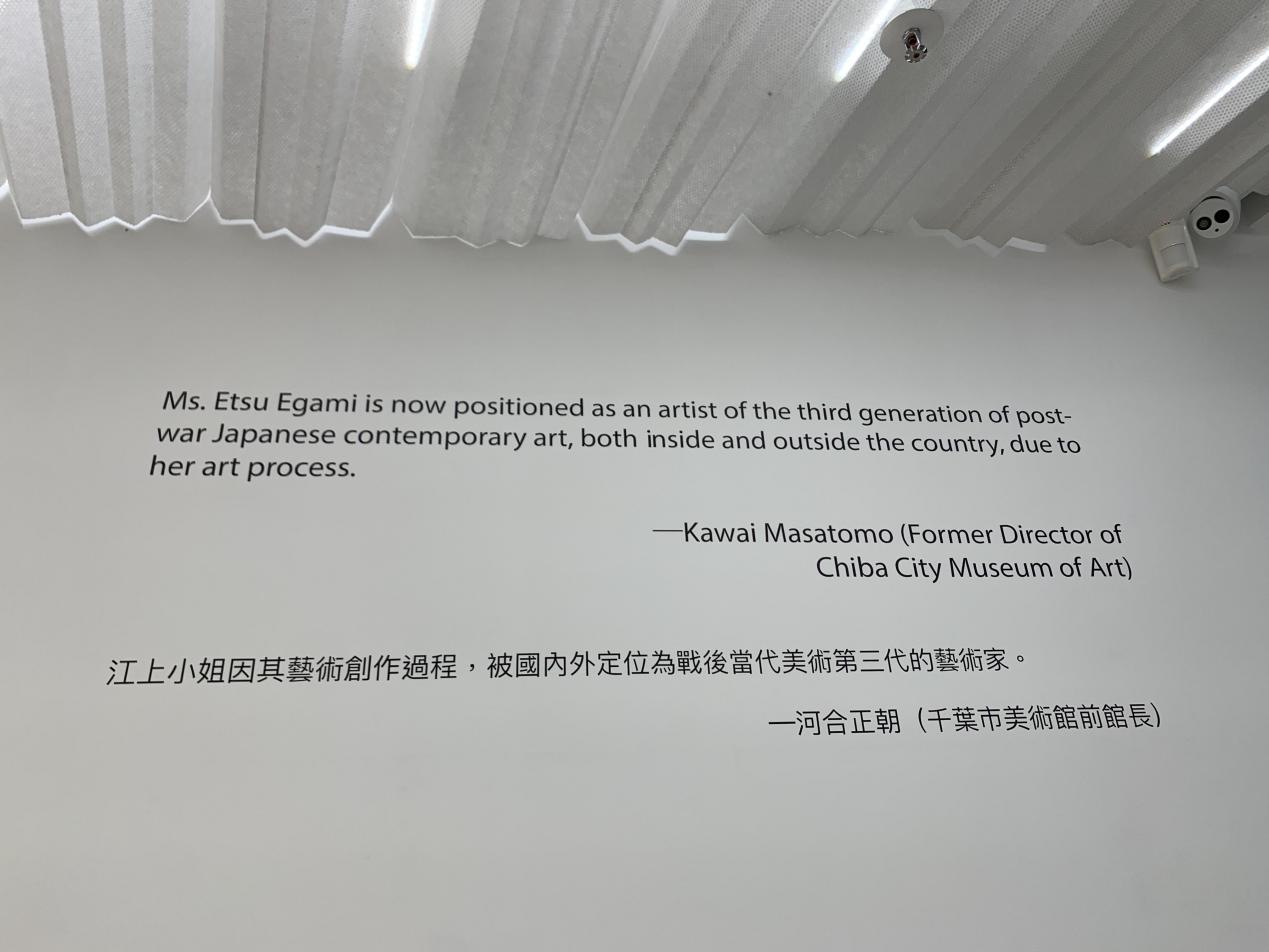
江上越个展“一期一会”现场 白石画廊香港-5 ⒸEtsu Egami
Faces are a primary subject matter for Etsu, who must have spent years staring into another’s eyes to try to figure out what they were saying to her as she traveled through the US, Europe and later China. In these places where her native Japanese is neither spoken or readily understood, she personally encountered an inability to communicate. Those moments where there was a total lack of communication—or understandings reach through voice tone and facial expression—are deeply rooted in this artist’s psyche. So we encounter face-after-face, not a legacy of historic figures or a roster of contemporary celebrities, but ordinary folks that Etsu encounters along the way of preparing a show.
Depictions of faces are controversial and even dangerous these days. There is a great deal of animosity towards facial recognition technology, for example, which people fear as a means of controlling activity and invading the subject’s privacy. At the same time, people are posting an unlimited stream of “selfies” on social media, relinquishing any rights to privacy without care. This pervasiveness of face-time is inspiring to Etsu, but also worthy of further investigation. As opposed to Richard Prince who merely appropriated posts from Instagram, Etsu has reinvented how to approach a face, how to see a face and how to paint a face. Most of all—as any of us looking at baby pictures or drivers’ licenses know—the face is ever-changing and ephemeral. It ages, it acts out emotion, it may even reveal a kind of truth about the person. But it is, unlike art, impermanent. How to capture this quality without destroying portraiture?
Etsu Egami has been incorporating portraits into her installations since her graduation work, This is no a Mis-hearing Game (2016). Trying to capture the “sound” of communication as expressed on the face of her subjects, she started an interactive, socially engaged performance. In it understanding among the participants deteriorates as they try to repeat the words said to them by the previous player. In its completion, Etsu created a series of portraits of each of the participants. These pictures are the beginning of rendering the face in broad strokes and sheer layers of paint, quite unlike Old Master paintings or contemporary realists.
In these loose interpretations of humanity, Etsu cleverly creates a “glitch” or visual white noise. Images created by computer often have these glitches, e.g. a deterioration into pixels or an erroneous smear of ink from a faulty printer. Several painters have been trying to approach this new aesthetic because the fault lines of perfection offered by new media are much more interesting than the images produced seamlessly by software and apps.
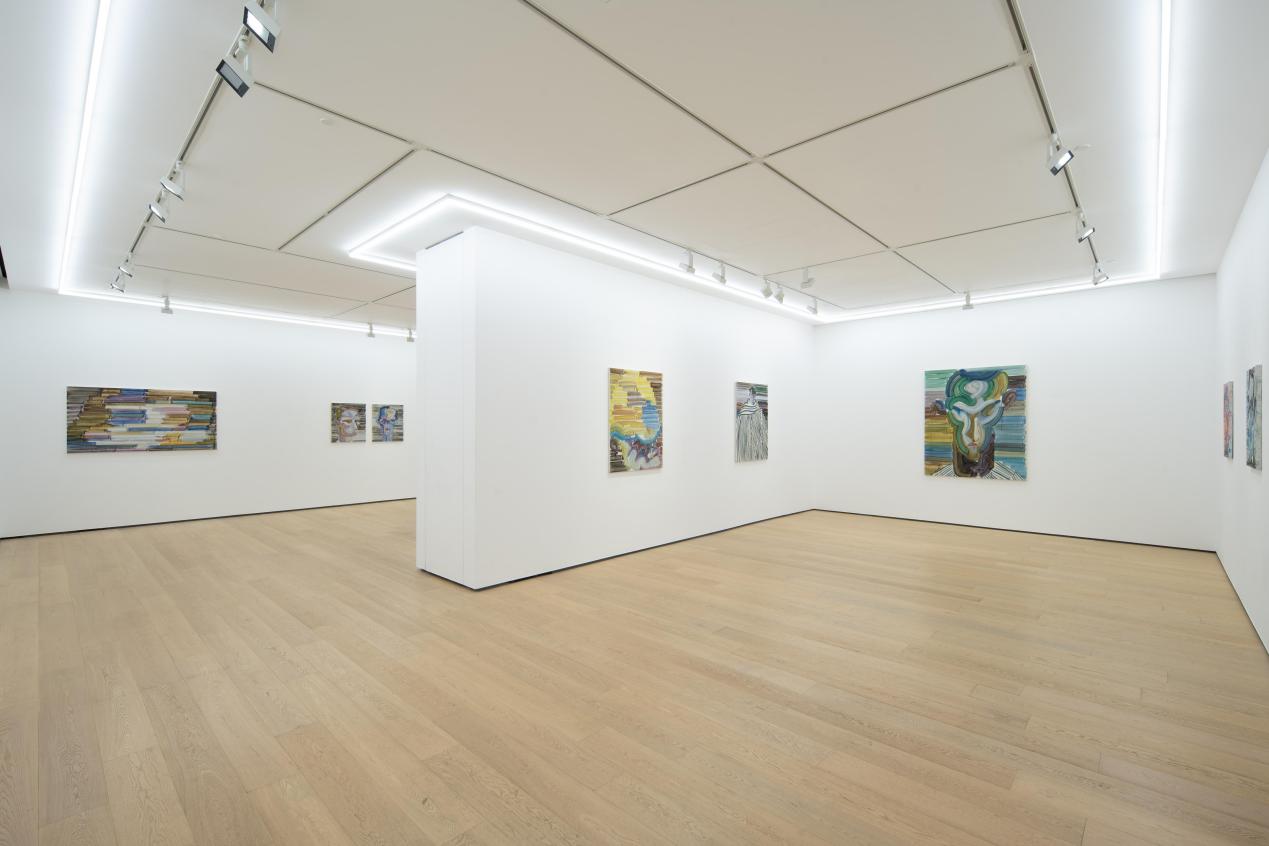
江上越个展“一期一会”现场 白石画廊香港-6 ⒸEtsu Egami
In the Rainbow series from 2020, broad strokes of sheer colors emerge as features of a face against a backdrop of parallel lines, like a monitor on the fritz. Or in her Social Distancing series, bodies come into focus from a haze of pastel clouds. And in the series, Autre, famous authors are seen but not seeable, as if their power and influence has waned over time. These various forms of “glitch” are meant to convey the ephemerality of time and the beauty of that impermanence. Yet, no one approach is definitive or finite. In Rainbows, there is the fleeting moment of a first encounter that never can be reenacted or preserved. In Social Distancing, there is the mis-communications between human beings, the longing and desire that comes from distance, which according to the old phrase, “makes the heart grow fonder.” In Autre, fame and significance cannot always endure the passage of time, no matter what the glory and greatness of the subject’s achievements. In fact, it is fascinating that Etsu has chosen authors who are known for their narratives packed with social commentary. The artist herself is trying to achieve something akin to Zola or Tolstoy, simultaneously reinventing narrative as a metaphor for meaning.
All of these works were made in Beijing during the first wave of the pandemic when travel was impossible and their emphasis on time is particularly suited to the period of lockdown when we all had to live “one day at a time.” The pandemic frames these works and alters our initial understanding of the phrase, Ichi-go ichi-e . The aura of death hovers on the surface of these works, never requiring us to see its impact but the impact is there nonetheless. Of the many paintings created in the past year. Etsu Egami’s are some of the most meaningful. Perhaps because it is embedded in her DNA, it seems that Etsu has been investigating a kind of social distancing—distance due to language or cultural differences—throughout her career. She is not jumping on a bandwagon or worse yet, capitalizing on a worldwide disaster. In her panopticon of faces, we see humanity. These paintings make us want to meet those figures and start a conversation, maybe to perpetuate more confusion or maybe to find out that we are capable to bridge our differences and understand each other.
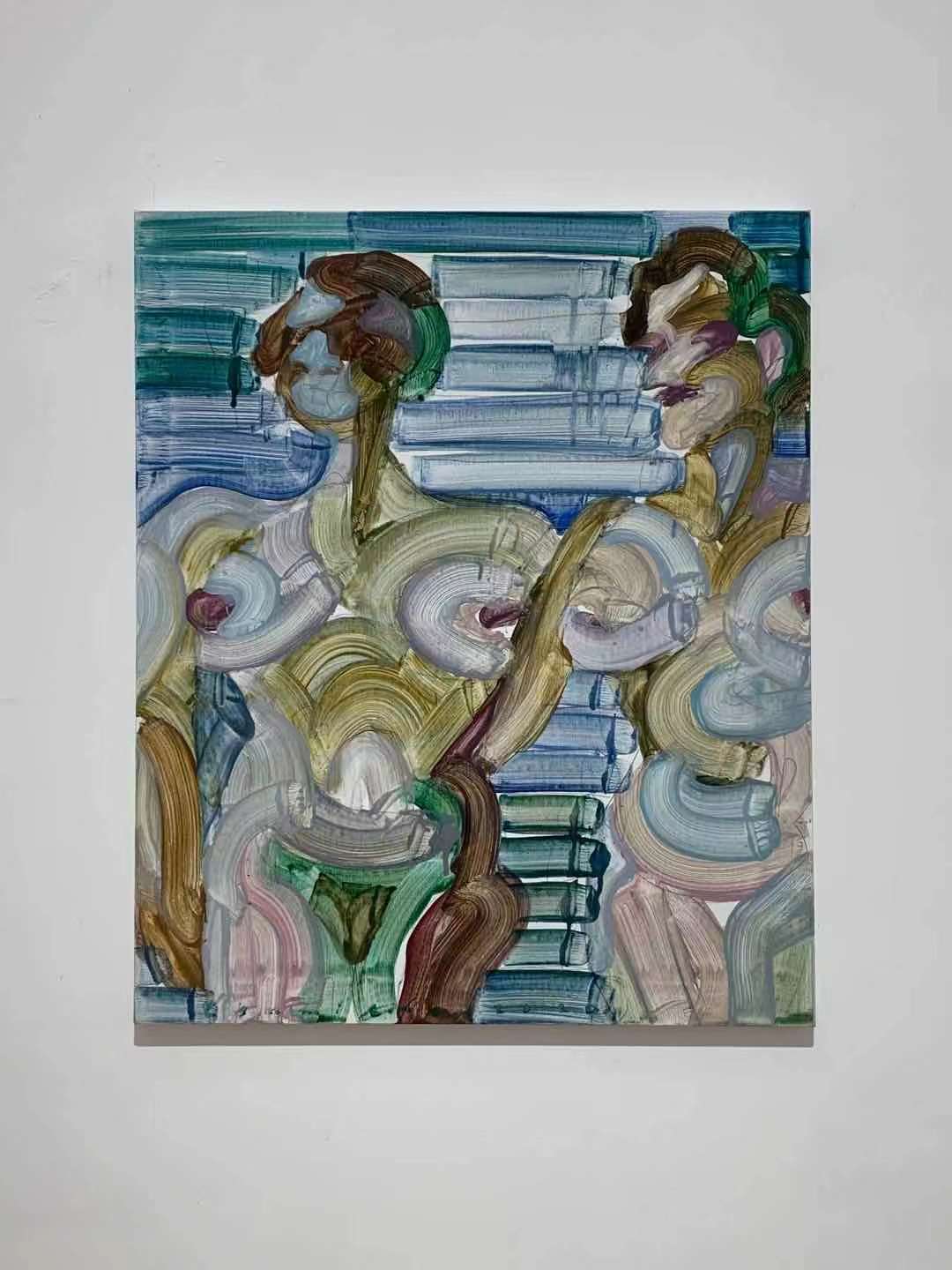
香港收藏家林伟而(William Lim)在江上越的个展中
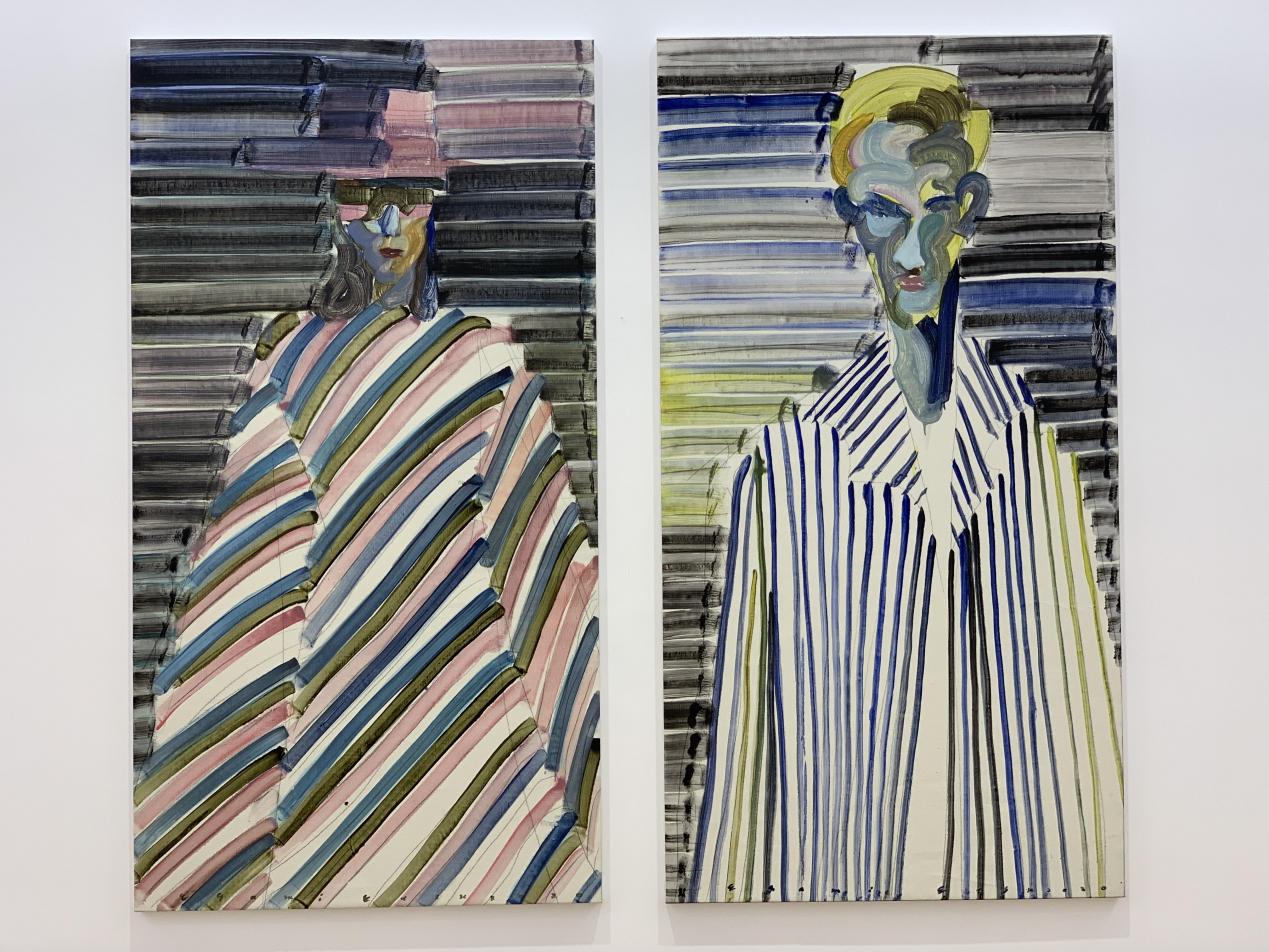
江上越个展“一期一会”现场 白石画廊香港-7ⒸEtsu Egami
《一期一会 ——江上越个展》
展览地点:白石画廊香港 HQueens
7-8/F, H Queen’s, 80 Queen’s Road Central, Hong Kong
展览时间: 8月5日 — 8月24日
|